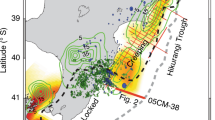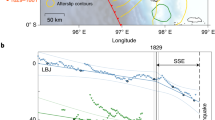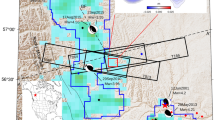Abstract
Recent seismic and geodetic observations indicate that interseismic creep rate varies in both time and space. The spatial extent of creep pinpoints locked asperities, while its temporary accelerations, known as slow-slip events, may trigger earthquakes. Although the conditions promoting fault creep are well-studied, the mechanisms for initiating episodic slow-slip events are enigmatic. Here we investigate surface deformation measured by radar interferometry along the central San Andreas Fault between 2003 and 2010 to constrain the temporal evolution of creep. We show that slow-slip events are ensembles of localized creep bursts that aseismically rupture isolated fault compartments. Using a rate-and-state friction model, we show that effective normal stress is temporally variable on the fault, and support this using seismic observations. We propose that compaction-driven elevated pore fluid pressure in the hydraulically isolated fault zone and subsequent frictional dilation cause the observed slow-slip episodes. We further suggest that the 2004 Mw 6 Parkfield earthquake might have been triggered by a slow-slip event, which increased the Coulomb failure stress by up to 0.45 bar per year. This implies that while creeping segments are suggested to act as seismic rupture barriers, slow-slip events on these zones might promote seismicity on adjacent locked segments.
This is a preview of subscription content, access via your institution
Access options
Access Nature and 54 other Nature Portfolio journals
Get Nature+, our best-value online-access subscription
$29.99 / 30 days
cancel any time
Subscribe to this journal
Receive 12 print issues and online access
$259.00 per year
only $21.58 per issue
Buy this article
- Purchase on Springer Link
- Instant access to full article PDF
Prices may be subject to local taxes which are calculated during checkout


Similar content being viewed by others
References
Pacheco, J. F., Sykes, L. R. & Scholz, C. H. Nature of seismic coupling along simple plate boundaries of the subduction type. J. Geophys. Res. 98, 14133–14159 (1993).
Perfettini, H. et al. Seismic and aseismic slip on the central Peru megathrust. Nature 465, 78–81 (2010).
Chlieh, M. et al. Distribution of discrete seismic asperities and aseismic slip along the Ecuadorian megathrust. Earth Planet. Sci. Lett. 400, 292–301 (2014).
Gao, X. & Wang, K. L. Strength of stick-slip and creeping subduction megathrusts from heat flow observations. Science 345, 1038–1041 (2014).
Carpenter, B. M., Saffer, D. M. & Marone, C. Frictional properties of the active San Andreas Fault at SAFOD: implications for fault strength and slip behavior. J. Geophys. Res. 120, 5273–5289 (2015).
Carpenter, B. M., Marone, C. & Saffer, D. M. Weakness of the San Andreas Fault revealed by samples from the active fault zone. Nat. Geosci. 4, 251–254 (2011).
Lockner, D. A., Morrow, C., Moore, D. & Hickman, S. Low strength of deep San Andreas Fault gouge from SAFOD core. Nature 472, 82–85 (2011).
Sibson, R. H. Fault zone models, heat flow, and the depth distribution of earthquakes in the continental crust of the United States. Bull. Seismol. Soc. Am. 72, 151–163 (1982).
Rice, J. R. in Earthquake Mechanics, Rock Deformation, and Transport Properties of Rocks (eds Evans, B. & Wong, T.-F.) 475–503 (Academic Press, San Diego, 1992).
Kodaira, S. et al. High pore fluid pressure may cause silent slip in the Nankai Trough. Science 304, 1295–1298 (2004).
Kato, A. et al. Propagation of slow slip leading up to the 2011 M w 9.0 Tohoku-Oki earthquake. Science 335, 705–708 (2012).
Schurr, B. et al. Gradual unlocking of plate boundary controlled initiation of the 2014 Iquique earthquake. Nature 512, 299–302 (2014).
Uchida, N., Iinuma, T., Nadeau, R. M., Burgmann, R. & Hino, R. Periodic slow slip triggers megathrust zone earthquakes in northeastern Japan. Science 351, 488–492 (2016).
Shelly, D. R. Possible deep fault slip preceding the 2004 Parkfield earthquake, inferred from detailed observations of tectonic tremor. Geophys. Res. Lett. 36, L17318 (2009).
Radiguet, M. et al. Triggering of the 2014 M w7.3 Papanoa earthquake by a slow slip event in Guerrero, Mexico. Nat. Geosci. 9, 829–833 (2016).
Shelly, D. R., Peng, Z. G., Hill, D. P. & Aiken, C. Triggered creep as a possible mechanism for delayed dynamic triggering of tremor and earthquakes. Nat. Geosci. 4, 384–388 (2011).
Wei, M., Liu, Y. J., Kaneko, Y., McGuire, J. J. & Bilham, R. Dynamic triggering of creep events in the Salton Trough, Southern California by regional M = 5.4 earthquakes constrained by geodetic observations and numerical simulations. Earth Planet. Sci. Lett. 427, 1–10 (2015).
Shirzaei, M., Bürgmann, R. & Taira, T. A. Implications of recent asperity failures and aseismic creep for time-dependent earthquake hazard on the Hayward fault. Earth Planet. Sci. Lett. 371–372, 59–66 (2013).
Nadeau, R. M. & McEvilly, T. V. Periodic pulsing of characteristic microearthquakes on the San Andreas Fault. Science 303, 220–222 (2004).
Khoshmanesh, M., Shirzaei, M. & Nadeau, R. M. Time-dependent model of aseismic slip on the central San Andreas Fault from InSAR time series and repeating earthquakes. J. Geophys. Res. 120, 6658–6679 (2015).
Williams, C. F., Grubb, F. V. & Galanis, S. P. Jr. Heat flow in the SAFOD pilot hole and implications for the strength of the San Andreas Fault. Geophys. Res. Lett. 31, L15S14 (2004).
Zoback, M. D. et al. New evidence on the state of stress on the San Andreas Fault system. Science 238, 1105–1111 (1987).
Fulton, P. M. & Saffer, D. M. Potential role of mantle-derived fluids in weakening the San Andreas Fault. J. Geophys. Res. 114, B07408 (2009).
Wei, M., Kaneko, Y., Liu, Y. & McGuire, J. J. Episodic fault creep events in California controlled by shallow frictional heterogeneity. Nat. Geosci. 6, 566–570 (2013).
Turner, R. C., Shirzaei, M., Nadeau, R. M. & Buergmann, R. Slow and go: pulsing slip rates on the creeping section of the San Andreas Fault. J. Geophys. Res. 120, 5940–5951 (2015).
Shirzaei, M. A wavelet-based multitemporal DInSAR algorithm for monitoring ground surface motion. IEEE Geosci. Remote Sens. Lett. 10, 456–460 (2013).
Khoshmanesh, M. & Shirzaei, M. Multiscale dynamics of aseismic slip on central San Andreas Fault. Geophys. Res. Lett. 45, 2274–2282 (2018).
Jolivet, R. et al. The burst-like behavior of aseismic slip on a rough fault: the creeping section of the Haiyuan Fault, China. Bull. Seismol. Soc. Am. 105, 480–488 (2015).
Schmittbuhl, J., Schmitt, F. & Scholz, C. Scaling invariance of crack surfaces. J. Geophys. Res. 100, 5953–5973 (1995).
Shibazaki, B. & Lio, Y. On the physical mechanism of silent slip events along the deeper part of the seismogenic zone. Geophys. Res. Lett. 30, 1489 (2003).
Kaproth, B. M. & Marone, C. Slow earthquakes, preseismic velocity changes, and the origin of slow frictional stick-slip. Science 341, 1229–1232 (2013).
Ikari, M. J., Marone, C., Saffer, D. M. & Kopf, A. J. Slip weakening as a mechanism for slow earthquakes. Nat. Geosci. 6, 468–472 (2013).
Liu, Y. J. & Rice, J. R. Spontaneous and triggered aseismic deformation transients in a subduction fault model. J. Geophys. Res. 112, B09404 (2007).
Segall, P., Rubin, A. M., Bradley, A. M. & Rice, J. R. Dilatant strengthening as a mechanism for slow slip events. J. Geophys. Res. 115, B12305 (2010).
Iio, Y., Kobayashi, Y. & Tada, T. Large earthquakes initiate by the acceleration of slips on the downward extensions of seismogenic faults. Earth Planet. Sci. Lett. 202, 337–343 (2002).
Perfettini, H. & Ampuero, J. P. Dynamics of a velocity strengthening fault region: implications for slow earthquakes and postseismic slip. J. Geophys. Res. 113, B09411 (2008).
Schmitt, S. V., Segall, P. & Matsuzawa, T. Shear heating-induced thermal pressurization during earthquake nucleation. J. Geophys. Res. 116, B06308 (2011).
Sleep, N. H. & Blanpied, M. L. Creep, compaction and the weak rheology of major faults. Nature 359, 687–692 (1992).
Sleep, N. H. Ductile creep, compaction, and rate and state dependent friction within major fault zones. J. Geophys. Res. 100, 13065–13080 (1995).
Byerlee, J. Model for episodic flow of high-pressure water in fault zones before earthquakes. Geology 21, 303–306 (1993).
Ruina, A. Slip instability and state variable friction laws. J. Geophys. Res. 88, 10359–10370 (1983).
Malservisi, R., Furlong, K. P. & Gans, C. R. Microseismicity and creeping faults: hints from modeling the Hayward Fault, California (USA). Earth Planet. Sci. Lett. 234, 421–435 (2005).
Tormann, T., Wiemer, S., Metzger, S., Michael, A. & Hardebeck, J. L. Size distribution of Parkfield’s microearthquakes reflects changes in surface creep rate. Geophys. J. Int. 193, 1474–1478 (2013).
Blanpied, M. L., Lockner, D. A. & Byerlee, J. D. An earthquake mechanism based on rapid sealing of faults. Nature 358, 574–576 (1992).
Leclere, H., Faulkner, D., Wheeler, J. & Mariani, E. Permeability control on transient slip weakening during gypsum dehydration: implications for earthquakes in subduction zones. Earth Planet. Sci. Lett. 442, 1–12 (2016).
Hillers, G. & Miller, S. A. Dilatancy controlled spatiotemporal slip evolution of a sealed fault with spatial variations of the pore pressure. Geophys. J. Int. 168, 431–445 (2007).
Mittempergher, S. et al. Evidence of transient increases of fluid pressure in SAFOD phase III cores. Geophys. Res. Lett. 38, L03301 (2011).
Morrow, C. A., Lockner, D. A., Moore, D. E. & Hickman, S. Deep permeability of the San Andreas Fault from San Andreas Fault Observatory at Depth (SAFOD) core samples. J. Struct. Geol. 64, 99–114 (2014).
Lockner, D. A. & Byerlee, J. D. An earthquake instability model based on faults containing high fluid pressure compartments. Pure Appl. Geophys. 145, 717–746 (1995).
Waldhauser, F. & Schaff, D. P. Large-scale relocation of two decades of Northern California seismicity using cross-correlation and double-difference methods. J. Geophys. Res. 113, B08311 (2008).
Johanson, I. A., Fielding, E. J., Rolandone, F. & Burgmann, R. Coseismic and postseismic slip of the 2004 Parkfield earthquake from space-geodetic data. Bull. Seismol. Soc. Am. 96, S269–S282 (2006).
Perfettini, H. & Avouac, J. P. Modeling afterslip and aftershocks following the 1992 Landers earthquake. J. Geophys. Res. 112, B07409 (2007).
Parsons, T. Post-1906 stress recovery of the San Andreas fault system calculated from three-dimensional finite element analysis. J. Geophys. Res. https://doi.org/10.1029/2001JB001051 (2002).
Okada, Y. Internal deformation due to shear and tensile faults in a half-space. Bull. Seism. Soc. Am. 82, 1018–1040 (1992).
Schmittbuhl, J., Vilotte, J. P. & Roux, S. Reliability of self-affine measurements. Phys. Rev. E 51, 131–147 (1995).
Candela, T. et al. Roughness of fault surfaces over nine decades of length scales. J. Geophys. Res. 117, B08409 (2012).
Richter, C. F. Elementary Seismology 768 (Freeman, San Francisco, 1958).
Utsu, T. A method for determining the value of b in a formula log n = a - bM showing the magnitude–frequency relation for earthquakes. Geophys. Bull. Hokkaido Univ. 13, 99–103 (1965).
Bender, B. Maximum likelihood estimation of b values for magnitude grouped data. Bull. Seismol. Soc. Am. 73, 831–851 (1983).
Shi, Y. & Bolt, B. A. The standard error of the magnitude–frequency b value. Bull. Seismol. Soc. Am. 72, 1677–1687 (1982).
Woessner, J. & Wiemer, S. Assessing the quality of earthquake catalogues: estimating the magnitude of completeness and its uncertainty. Bull. Seism. Soc. Am. 95, 684–698 (2005).
Tormann, T., Wiemer, S. & Mignan, A. Systematic survey of high-resolution b value imaging along Californian faults: inference on asperities. J. Geophys. Res. Solid Earth 119, 2029–2054 (2014).
Schorlemmer, D., Wiemer, S. & Wyss, M. Earthquake statistics at Parkfield: 1. Stationarity of b values. J. Geophys. Res. 109, B12307 (2004).
Acknowledgements
This study was funded by National Science Foundation grants EAR-1357079 and EAR-1735630, and NASA Earth and Space Fellowship No. 80NSSC17K0371. The InSAR time series was obtained from refs 20,]25. The seismic catalogue was obtained from ref. 50. The creepmeter data at Slacks Canyon were obtained from the United States Geological Survey. We greatly thank H. Perfettini and D. Shelly for comments and suggestions.
Author information
Authors and Affiliations
Contributions
M.K. performed the data analyses and modelling, interpreted the results, prepared figures displaying the results and wrote the manuscript. M.S. contributed to modelling, interpretation and editing the manuscript.
Corresponding author
Ethics declarations
Competing interests
The authors declare no competing interests.
Additional information
Publisher’s note: Springer Nature remains neutral with regard to jurisdictional claims in published maps and institutional affiliations.
Supplementary information
Supplementary Information
Supplementary Figures.
Supplementary Movie
Time series of cumulative surface deformation in LOS direction during 2003–2010.
Rights and permissions
About this article
Cite this article
Khoshmanesh, M., Shirzaei, M. Episodic creep events on the San Andreas Fault caused by pore pressure variations. Nature Geosci 11, 610–614 (2018). https://doi.org/10.1038/s41561-018-0160-2
Received:
Accepted:
Published:
Issue Date:
DOI: https://doi.org/10.1038/s41561-018-0160-2
This article is cited by
-
Autonomous extraction of millimeter-scale deformation in InSAR time series using deep learning
Nature Communications (2021)
-
Measuring, modelling and projecting coastal land subsidence
Nature Reviews Earth & Environment (2020)
-
How satellite InSAR has grown from opportunistic science to routine monitoring over the last decade
Nature Communications (2020)




